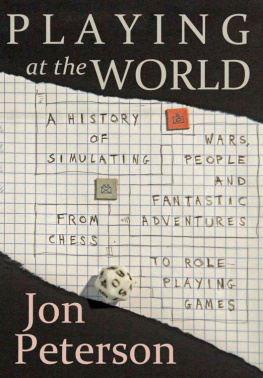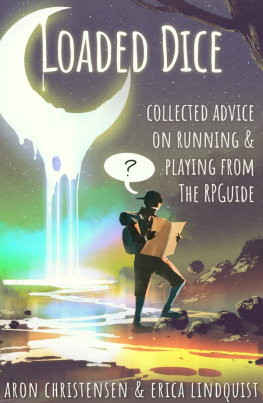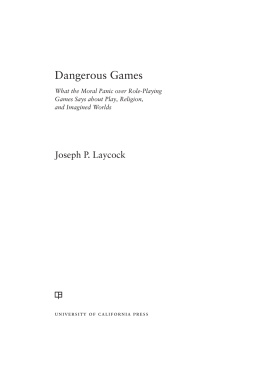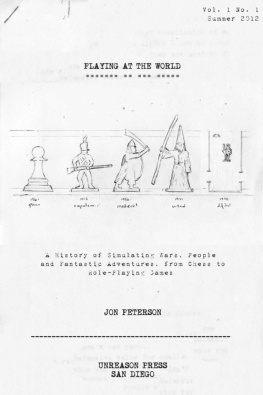
Unreason Press, Box 90656, San Diego, CA 92109
2012 by Unreason Press LLC.
All rights reserved. Second printing, October 2013.
ISBN: 978-0-615-67460-5 (Kindle)
Figure 8 appears by permission of Don Perrin. Figure 15 appears courtesy of Robert E. Howard Properties. Figure 23 appears by special permission of the City of Bayeux. Figure 25 is The Trustees of the British Museum. Figure 26 appears courtesy of the Houghton Library of Harvard University. Figure 37 appears by permission of John Curry. Figure 38 appears by permission of Getty Images, Time & Life Pictures, Leonard McCombe. Figure 42 appears by permission of Mike Mornard. Figure 49 appears by permission of the Gygax Estate. Figure 52 appears by permission of the Philip A. Harrington Estate. Figure 54 appears courtesy of the Minnesota Historical Society. Figure 57 appears by permission of Caliver Books. Figure 64 appears by permission of Flying Buffalo; Tunnels & Trolls is a trademark of Flying Buffalo, Inc. www.flyingbuffalo.com.
Figure 24 is 1973 Conan Properties International LLC. CONAN andrelated logos, names, characters and distinctive likeness thereof aretrademarks and copyrights of Conan Properties International LLC. All rightsreserved.
Figures 18, 22 and 59appear by permission of Marvel Worldwide. Doctor Strange, the Mighty Thor andall other Marvel characters: TM & 2012 MarvelEntertainment, LLC and its subsidiaries. All rights reserved.
Figures 20 and 47 appear courtesy of the British Library. The British Library Board, Ashley 2468, f.1; Harley 3244, f.59.
Figure 29 appears courtesy of the House of Hohenzollern, HRH Georg Friedrich Prince of Prussia, SPSG. Photographer: Roman Mrz.
Dungeons & Dragons is a trademark of WizardsLLC, a division of the Hasbro Corporation. Unreason Press gratefullyacknowledges the generosity of Wizards LLC for its non-objection to the use ofmany figures.
All trademarks and service marks referenced in this work are theproperty of their respective owners.
Back cover: Detail of Tab. 2 from Venturinis Beschreibung und Regeln eines neuen Krieges-Spiels zum Nutzen undVergngen, besonders aber zum Gebrauche in Militairschulen (1797).
www.unreason.com
Contents
Figures
Introduction
In the second half of the twentieth century, an innovative form of mass-marketentertainment captivated a young adult audience: games of simulation. The first commercial products in this genre, the board wargames sold by Avalon Hill and others,reached a small but devoted fan base with titles that let players refighthistorical battles. After two decades of modest success, this industry took asurprising turn. Growing interest in fantasy genre fiction combined with theprinciples of wargaming to create the new category of role-playing games, which began with the hugely popular Dungeons & Dragons (1974). In these games, playersmanaged individual characters more so than the vast armies common in wargames, andthe scope of agency of these characters encompassed far more than justconflict. Although role-playing games still relied heavily on the systems of wargames,they are distinguished by the many innovations present in the flagship title Dungeons& Dragons.
The earliest account of the history of Dungeons& Dragons also ranks among the briefest. Gary Gygax included it in a letter to Alarums & Excursions in July 1975, onlysixteen months after the first sales of the game, and it reads as follows:
In case you dont know the history of D&D, it allbegan with the fantasy rules of Chainmail. Dave A took these rules andchanged them into a prototype of what is now D&D. When I played inhis Blackmoor campaign I fell in love with the new concept and expanded andchanged his 20 or so pages of hand-written rules into about 100 ms. pages.Daves group and ours here in Lake Geneva then began eager and enthusiasticplay-testing, and the result was the D&D game in January of 1974. [A&E:#2]
Chainmail, a miniature wargame Gygax releasedin 1971, focused on simulating the medieval period but also included a smallappendix detailing a fantasy setting, one largely derived from the works ofTolkien. Dave Arneson used the Chainmail rules as the basis for hisseminal Blackmoor fantasy game, which pioneered dungeon exploration and manyother elements essential to the invention of Dungeons & Dragons.Gygax transformed Arnesons Blackmoor from a local phenomenon known only in aMinneapolis gaming group to a commercial product, and even founded a company tosell it. As Gygaxs paragraph-length account seems to explain all of theimmediate background, one may well wonder how greatly our understanding willbenefit from meticulous expansion of the history of these games. After all, whylavish some hundreds of pages of scrupulous attention on a fad of juvenilepopular culture, one whose zenith passed decades ago? In its own defense, thisstudy must submit by way of introduction a few reasons for believing a deeperinvestigation of the phenomenon of role-playing games will prove worthwhile.
In the first place, enthusiasts would protestthat the significance of Dungeons & Dragons in the twenty-first-centurymarketplace is easily underestimated. The introduction of so novel a gametransformed our culture, and brought to the mainstream ideas and practicespreviously relegated to small societies clustered around wargames and genrefiction. As its early converts grappled with its implications, they struggledto relate what they found in Dungeons & Dragons to prior experiences.One fan promised that if you took everything possible or impossible you everdreamed about, read about, or imagined; put it in a medieval setting, andheaped it all into one set of rules for a game, you would have Dungeons& Dragons. A second pioneer recognized that Gygax and Arneson hadcreated a new order of game, one so addictive that another early commentatorfears its worse than heroin. As the progenitor of all role-playing games, Dungeons & Dragons setin motion cultural forces which only gather momentum with the passage of time. Althoughthe original pencil-and-paper game claims fewer devotees than it did thirtyyears ago, literally thousands of role-playing games compete in the market, andsome massively multiplayer online role-playing games can boast over ten million subscribers. Focusing solely on these obvious descendants of the role-playing games of the1970s, however, neglects the more pervasive influence of their celebratedancestor. The fundamental principles of simulation popularized by Dungeons& Dragonsconcepts like a character enduring a specific quantity of damage before death, and improving skills with experiencenow permeate virtually all video game genres.
Furthermore, a history must reach beyond the immediatebackground of role-playing games to expose the broader cultural context inwhich fantasy and simulation arose. Dungeons & Dragons did notresult solely from the activity of hobby gamers, as that community relied on adiverse, interdisciplinary web of influences in genre fiction, historicalscholarship, military science, psychology, mathematics and mythology. This isnot to say that the authors of Dungeons & Dragons always followedthese sources knowinglythese ideas suffused twentieth-century popular culture,and the paths of transmission were often forgotten or even deliberatelyobscured. This leaves posterity with a number of difficult questions about theorigins of simulation gaming. When were the principles of simulation invented,and who first rolled dice to decide events in a game? How did games move beyondsimulating armies at war and into the simulation of individual people? Why doesthe fantasy genre inspire its fans to want more than just to read about magicaladventures, but actually to experience them, in some meaningful fashion? To investigatethese matters, one must go back not just years or decades but centuries. Previousattempts to detail the history of wargaming have suffered greatly from lack ofaccess to foundational material, both the scarce fanzines of early hobbyistsand the far older military training methods documented in volumes that havenever been translated into English. While fantasy literature has received agreat deal of academic scrutiny, the genre works that informed the setting ofpopular fantasy games have not previously been analyzed to demonstrate how theyrepackaged mythology in a form suitable for simulation. It is perhaps the boldestambition of this book to recover that context, to show these games in their properrelation to intellectual history.









